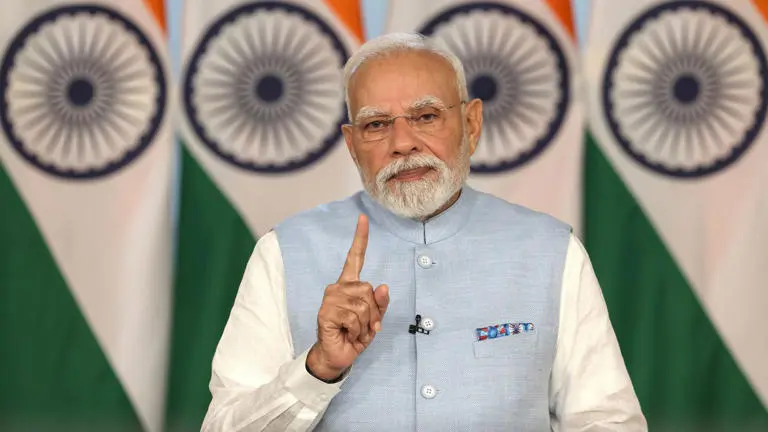
How GST 2.0 Unlocks Massive Savings and Swadeshi Pride for the Middle Class
GST Bachat Utsav: How PM Modi’s Swadeshi Push Promises Big Savings for Every Indian Home – India is stepping into a new economic chapter with the launch of GST 2.0, and Prime Minister Narendra Modi’s recent address has set the tone for what he calls a “double bonanza” for the poor, middle class, and neo-middle class. With the festive season of Navratri as the backdrop, the Prime Minister unveiled sweeping reforms that aim to simplify taxation, boost local industries, and empower citizens through savings and self-reliance.
Let’s break down this major announcement in simple terms and explore how it affects your wallet, your shopping choices, and the future of Indian businesses.
What Is GST Bachat Utsav and Why It Matters
The term “GST Bachat Utsav” translates to “GST Savings Festival,” and it’s not just a catchy slogan. Starting from the first day of Navratri, the government has rolled out new GST rates that reduce taxes on hundreds of everyday items from groceries and medicines to electronics and automobiles.
Here’s what’s changing:
- A simplified two-slab GST structure: 5% for essential goods and 18% for most other items.
- A special 40% “demerit rate” only for luxury and sin goods like tobacco and high-end cars.
- Over 375 items have seen tax reductions, making them more affordable for consumers.
This reform replaces the earlier four-slab system, which many found confusing and burdensome. By streamlining the tax structure, the government hopes to make compliance easier for businesses and reduce costs for consumers.
What gets cheaper?
- Kitchen staples like cooking oil, pulses, and packaged food
- Medicines and medical equipment
- Household appliances and electronics
- Automobiles and consumer durables
According to PM Modi, these changes will lead to annual savings of ₹2.5 lakh crore for Indian citizens when combined with recent income tax reliefs.
Swadeshi Revival: A Call to Buy Made-in-India Products
In his address, PM Modi didn’t just talk about tax cuts—he made a passionate appeal for “Swadeshi,” urging citizens to choose locally made products over foreign brands.
Why Swadeshi matters today:
- It supports Indian manufacturers, especially MSMEs (Micro, Small & Medium Enterprises).
- It creates jobs and strengthens local economies.
- It reduces dependency on imports and boosts national self-reliance.
Modi linked this movement to India’s freedom struggle, where Swadeshi was a powerful tool against colonial rule. Today, he says, it can be a tool for economic freedom and prosperity.
How you can support Swadeshi:
- Buy products labeled “Made in India”
- Choose local brands for clothes, food, and electronics
- Encourage small businesses and artisans in your area
Modi’s message was clear: “Every home should become a symbol of Swadeshi, and every shop should be adorned with Swadeshi goods”.
Big Boost for MSMEs and the Neo-Middle Class
One of the most impactful parts of the GST reform is its focus on MSMEs – the backbone of India’s economy. These small and medium businesses often struggle with complex tax rules and high compliance costs. The new GST structure aims to change that.
Benefits for MSMEs:
- Lower tax rates mean reduced financial burden
- Simplified rules and procedures make compliance easier
- Increased sales due to more affordable pricing
Modi emphasized that MSMEs will now enjoy a “double benefit”—lower taxes and higher demand. This is expected to revive many struggling businesses and encourage new entrepreneurs to enter the market.
Who else benefits?
- The “neo-middle class” – 25 crore Indians who have recently risen out of poverty
- Farmers, women, youth, and traders
- Anyone looking to save more and spend wisely
With income up to ₹12 lakh now tax-free and GST rates slashed, the middle class is set to enjoy more disposable income and better purchasing power.
Aatmanirbhar Bharat: Reform, Resilience, and Future Growth
The GST 2.0 rollout is part of a larger vision—Aatmanirbhar Bharat, or “Self-Reliant India.” Modi described reform as a continuous process, one that evolves with the country’s needs and dreams.
How GST 2.0 fits into this vision:
- It simplifies business operations, making India more attractive to investors
- It boosts consumption-driven growth by increasing purchasing power
- It strengthens the foundation for inclusive development across states
The GST Council, which includes both central and state governments, unanimously approved these reforms. This shows a shared commitment to economic progress and cooperative federalism.
Global context: The announcement comes amid rising trade tensions with the US, including a steep hike in H-1B visa fees. Modi’s swadeshi pitch is also a strategic response to global uncertainties, encouraging domestic production and consumption.
Final Thoughts: What This Means for You
Whether you’re a homemaker, a student, a shopkeeper, or a small business owner, GST 2.0 is designed to make life easier and more affordable. It’s not just about tax, it’s about empowerment, savings, and pride in Indian products.
Your takeaway:
- Expect lower prices on daily essentials and big-ticket items
- Support local businesses and swadeshi products
- Enjoy more savings thanks to income tax and GST reforms
- Be part of a national movement toward self-reliance and inclusive growth
As PM Modi said, “This is not just a reform, it’s a celebration. A festival of savings, self-reliance, and shared prosperity.”
So this Navratri, as you light your diyas and decorate your homes, know that the spirit of Swadeshi and the promise of GST Bachat Utsav are lighting up India’s economic future too.
Also read: Diwali 2025 Car Buying Guide: GST Reforms, New Launches, and Festive Discounts Explained
Modi’s GST Makeover: Cheaper Essentials, Simpler Taxes and a Diwali Gift for Every Indian
Stay informed with the latest news and updates – only on Rapido Updates.